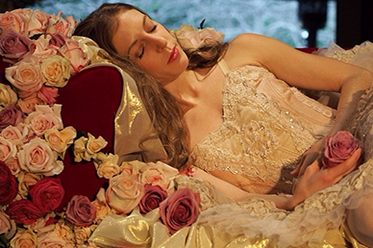 The Australian Ballet has unveiled its 2015 season, celebrating the unique beauty, artistry and athleticism of ballet including a lavish new production of The Sleeping Beauty.
The Australian Ballet has unveiled its 2015 season, celebrating the unique beauty, artistry and athleticism of ballet including a lavish new production of The Sleeping Beauty.
“Ballet embodies all that is beautiful about the human experience, says Artistic Director David McAllister. “In Australia, we have our own unique beauty that is powered by athleticism. Our dancers have a strength that is dynamic, fearless and exciting, which reflects our rich and inclusive Australian culture.”
The centrepiece of the season is an opulent new production of The Sleeping Beauty, directed by Artistic Director David McAllister. Representing the dynamic athleticism of ballet is the contemporary season 20:21, including a world premiere from Resident Choreographer Tim Harbour with sets created by trailblazing Australian architect Kelvin Ho.
2015 also includes Maina Gielgud’s renowned production of Giselle; a season dedicated to the genius of British choreographer Frederick Ashton, The Dream; and – by popular demand – an encore season of Alexei Ratmansky’s Cinderella in Melbourne and the return of Graeme Murphy’s Swan Lake in Sydney.
David McAllister’s The Sleeping Beauty will stay true to the traditional ballet (which premiered in 1890) with clever re-imaginings for the modern age. Against the inimitable Tchaikovsky score, sets and costumes by multi-award-winning designer Gabriela Tylesova (Love Never Dies) will evoke the splendour of the Imperial court. Hundreds of skilled artists and artisans will work over the next year on creating the new ballet, which makes its world premiere in Melbourne (15 – 26 September), before touring to Perth (7 – 10 October) and Sydney (27 November – 16 December).
The 2015 season commences in February with a Sydney-only season of Graeme Murphy’s Swan Lake at the Capitol Theatre (20 – 28 February). This modern-day classic is The Australian Ballet’s most performed and most successful work; the Sydney run follows a sell-out Melbourne season in 2013. Murphy presents the romance of Odette and Prince Siegfried as a love triangle which resonates across the ages.
Giselle plays in Melbourne (13 – 23 March), Sydney (2 – 22 April), Canberra (21 – 26 May) and Adelaide (2 – 6 July). Premiering in 1841, Giselle is a ballet of yearning and supernatural forces that exemplifies the Romantic era. Maina Gielgud’s production – first staged in 1986, when she was then Artistic Director of The Australian Ballet – has offered generations of dancers the opportunity to inhabit the career-making role of Giselle.
The Dream celebrates the indelible influence of English choreographer Frederick Ashton, whose work with The Australian Ballet in its early years contributed significantly to the company’s development and style. The triple bill includes the titular The Dream, Ashton’s whimsical take on Shakespeare’s A Midsummer Night’s Dream, as well as two of his most celebrated short works, Monotones II and Symphonic Variations. It plays in Sydney (29 April – 16 May), Melbourne (4 – 13 June) and Adelaide (8 – 9 July).
Melbourne audiences will be offered an exclusive encore season of Alexei Ratmansky’s Cinderella (19 – 27 June), following sell outs in Melbourne, Sydney and Adelaide. Ratmansky created this production for The Australian Ballet in 2013, with Surrealism-inspired costumes and sets by Jérôme Kaplan, to the powerful music of Prokofiev’s original score.
Audiences will be treated to a thrilling night of modern ballet when 20:21 is presented in Melbourne (27 August – 5 September) and Sydney (5 – 21 November). Two vanguard contemporary works of the 20th century – George Balanchine’s Symphony in Three Movements (1947) and Twyla Tharps’ In The Upper Room (1987), both resonant of the era of New York in which they were created – will meet the 21st century, with a world premiere by Resident Choreographer Tim Harbour.
Beginning his career with works for The Australian Ballet’s choreographic development program Bodytorque, when he was still a dancer, Harbour went on to secure prestigious commissions for Christopher Wheeldon’s Morphoses and New York City Ballet. His creative partners on this yet-unnamed ballet include acclaimed Australian architect Kelvin Ho, founder of Akin Creative; and the makers of a specially commissioned electronic score.
20:21 comes in the wake of The Australian Ballet’s acclaimed Chroma contemporary season in 2014, which broke box-office records for the company and saw a significant uplift in new audiences.
The Australian Ballet’s Bodytorque program continues to evolve in 2015 with a series of surprise “pop-up” performances after selected shows of The Dream and 20:21 in Melbourne and Sydney. Bodytorque Up Late is the latest evolution of the decade-long Bodytorque program, which has nurtured numerous young choreographers.
“Our 2015 program marks the start of a five-year growth strategy designed to bring The Australian Ballet to more people than ever before,” says Libby Christie, Executive Director. “We will perform in Melbourne, Sydney, Adelaide, Perth, Canberra and Brisbane, as well as major regional centres, and undertake a significant tour to Beijing and Shanghai.”
The popular free Telstra Outdoor performance returns to Brisbane in May with Telstra Ballet in the Gardens. The Australian Ballet will also tour to Shanghai and Beijing, visit major regional centres in Australia, and continue its rich program of audience engagement events. Adelaide audiences will also get to choose from two separate seasons for the first time in a decade, and will have the opportunity to create a Season Package comprised of Giselle, The Dream and the popular McAllister in Conversation talk.
For more information, including performance dates and subscription packages, visit: www.australianballet.com.au/beauty
Image: Principal Artist Lana Jones – courtesy of The Australian Ballet
